Exploring the Artistry of Skateboarding Imagery
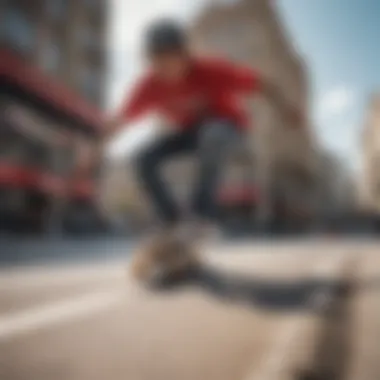
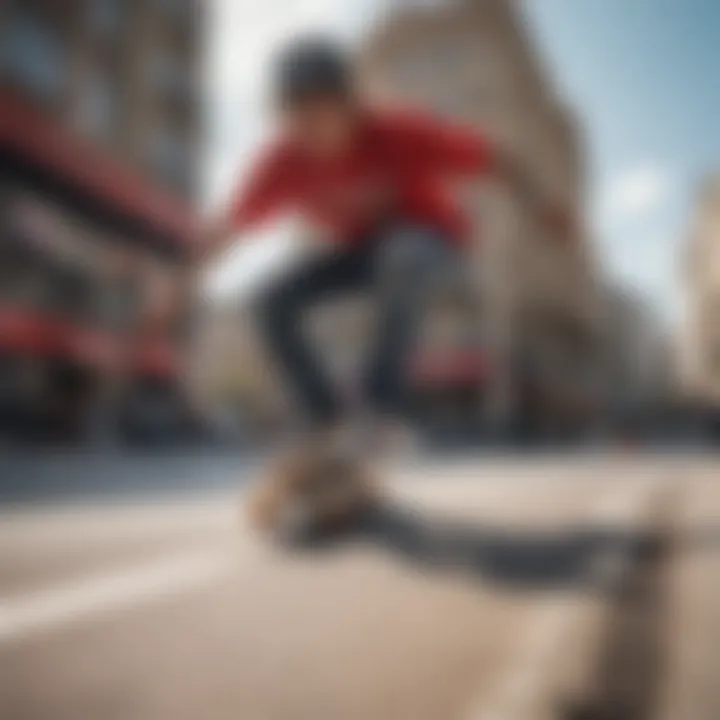
Intro
Skateboarding images tell a story that goes well beyond their surface level. Each photograph captures not just a person on a board but a slice of culture, a dash of creativity, and a moment frozen in time. As we meander through this artistic landscape, it’s essential to appreciate how these visuals shape perceptions of skateboarding. They do more than document tricks; they encapsulate emotions, lifestyle, and community.
The world of skateboarding has evolved tremendously since its inception. From its beginnings in the backyards of Southern California to the global phenomenon it has become today, skateboarding’s artistic representation has grown in depth and complexity. Every picture has the potential to serve as a medium of expression, blending various techniques and technologies. However, it’s not just about snapping a photo; it’s about capturing the spirit that lies within the skateboarding culture.
In this article, we'll embark on a thorough exploration of skateboarding images, discussing their historical significance, the photographers behind them, and the modern role of social media. Each section of this piece unfolds a nuanced perspective, shedding light on how the art of skate photography intertwines with identity and community—creating a rich tapestry that’s as intricate as the sport itself.
Techniques and Skills
To appreciate skateboarding images fully, one must first understand the techniques and skills that are often depicted in these visuals. Mastering the various tricks not only influences the imagery captured but also speaks volumes about the dedication and creativity of the skater.
Essential Tricks for Beginners
For those just starting, getting familiar with the fundamental tricks can profoundly affect their presence in photography:
- Ollie: The cornerstone of many tricks, this leap off the board sets the stage for creativity.
- Kickflip: A classic move that showcases agility and control, resulting in striking images.
- Heelflip: Similar to the kickflip but with a different foot motion, adding variety to skate sequences.
Getting these tricks down will offer not just the joy of executing them, but also the ability to capture impressive moments on film.
Advanced Techniques for Pros
As skaters progress, their images often showcase more advanced tricks that require considerable skill:
- 859 Switch Heelflip: A complex maneuver that, if executed perfectly, can create a mesmerizing visual spectacle.
- Rodeo Flip: Combining rotation and flips, creating an electrifying image that demonstrates control.
- Bowl Grinds: These shots reveal not just technique but the atmosphere of the skate environment.
Mastering these advanced techniques allows skaters to present a broader spectrum of their artistry through images, while also pushing the art form itself.
Skateboarding Culture
In the realm of skateboarding, the culture surrounding it is just as significant as the tricks. This culture has undergone a remarkable evolution, reflected in the images coming out of skate scenes around the globe.
The Evolution of Skateboarding
Skateboarding has transitioned from a subculture to a respected sport. It’s fascinating to see how this shift has been documented visually:
- Early Days: Black and white images portray the raw and rebellious spirit of novice skaters.
- Skate Parks: As parks emerged, the aesthetics of skateboarding photography evolved, introducing vibrant colors and dynamic shots.
- Digital Age: With technology progressing, skateboarding visuals are now widely shared on platforms like Instagram, impacting how the culture is perceived.
Influential Skateboarders and Their Impact
Certain skateboarders have left an indelible mark on not just the sport but also how it’s captured:
- Tony Hawk: His iconic tricks have become legendary, with images that inspired countless generations.
- Rodney Mullen: Often considered the godfather of street skating, his unique style shaped the visual narrative of urban skate culture.
- Nyjah Huston: A current superstar, his powerful performances have created a new breed of striking skate imagery that resonates with today’s youth.
Through skateboarding images, we gain insight into their lives, experiences, and the evolution of skate culture that they’ve contributed to. The visuals remind us of the connection between artistry and athleticism, creating a dialogue that resonates throughout the skate community.
"Skateboarding is a way of life, an art form that challenges both the body and the imagination."
As we delve deeper into the aspects of skateboarding imagery, we’ll explore how technological advancements and social media have transformed these representations further, amplifying their role in storytelling and community engagement.
Understanding Skateboarding Imagery
Skateboarding imagery encompasses more than just a series of snapshots capturing tricks; it reflects a culture rich in history and creativity. It serves as a medium for expressing the unique ethos and personalities within the skating community. As we venture into this exploration, we see that understanding skateboarding images reaches into various aspects, each revealing deeper connections to the sport and its culture.
Defining Skateboarding Images
To comprehend skateboarding imagery, we must first define what it entails. Primarily, skateboarding images can be classified into photographs, videos, and artworks that represent the sport. These visuals often showcase skaters executing complex tricks, cruising through urban landscapes, or engaging with the skateboard as an art form in itself.
They encapsulate the adrenaline and emotion of skating moments, ranging from the sheer triumph of nailing a difficult move to the camaraderie found in skate parks. Without artistic constraints, every frame speaks volumes and serves as a testament to individual expressions, styles, and techniques. The primary elements that form the foundation of skateboarding images include:
- Composition: How elements in the frame are arranged can tell a story—or even set a mood.
- Lighting: Harnessing natural or staged light can accentuate shadows and highlights, adding depth.
- Authenticity: Realness matters; skaters often prioritize capturing genuine moments over styled sets.
Furthermore, these images serve as documents of evolution in the sport, capturing shifts in technique and culture over time. Each snapshot or frame weaves into a tapestry of shared experiences, making skateboarding images a vital part of the sport's narrative.
The Role of Visuals in Skate Culture
Visuals in skate culture act as a conduit for communication and expression, allowing skaters to forge connections and share experiences with a broader audience. They go beyond documenting stunts; they tell narratives of persistence, community, and creativity.
A striking example is how skate magazines like Thrasher and Transworld Skateboarding have played an important role in shaping popular perceptions of skateboarding. Their pages filled with dynamic shots of skaters pushing boundaries not only inspire upcoming talent but also legitimize skateboarding as an art form. Similarly, platforms like Instagram serve as gallery spaces where skaters can showcase their work, share lifestyle moments, and connect with fellow enthusiasts. This digital evolution has fostered a sense of inclusivity, allowing voices from diverse backgrounds to emerge.
In this context, visuals function as tools of empowerment. They elevate the sport, giving skaters a platform to convey their emotions and unique perspectives. The intermingling of visuals and skate culture has also led to the emergence of subcultures within skating, each contributing to an ever-growing mosaic. Through photography, skaters have access to a means to shape their identity and craft an image to navigate both local and global communities.
"Skateboarding images are more than a visual spectacle; they're the heartbeat of a culture that thrives on creativity and community."
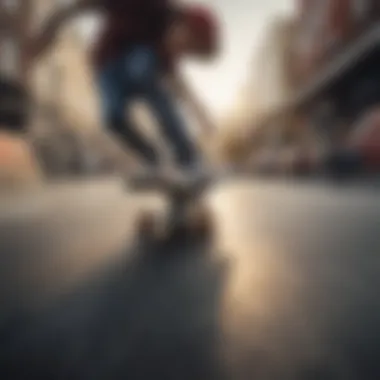
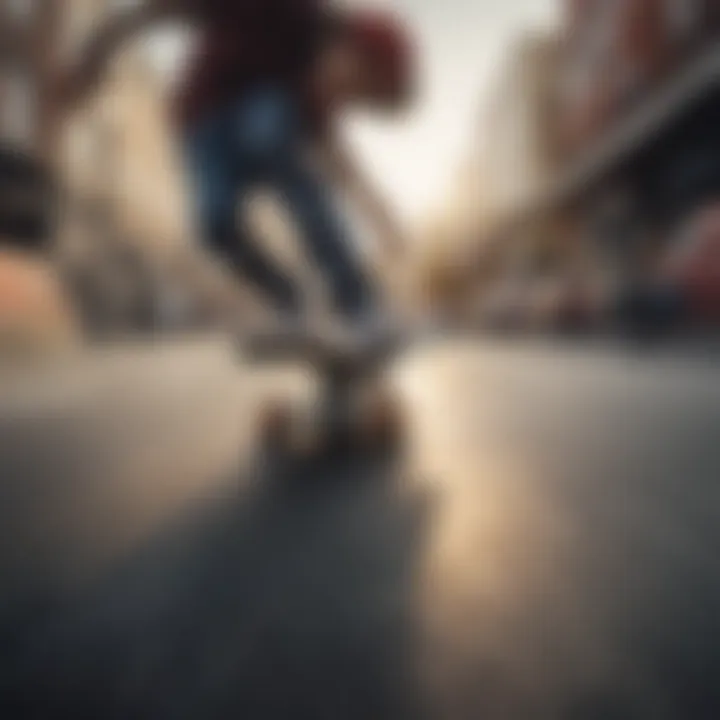
Understanding the vitality of these images encourages a deeper appreciation of skateboarding itself, urging both skateboarders and spectators to engage meaningfully with the artistry involved.
The Evolution of Skate Photography
The evolution of skate photography encapsulates a significant journey that not only mirrors the development of skateboarding itself but also paints a broader picture of youth culture, artistic expression, and technological advancement. To fully appreciate skateboarding images, it becomes crucial to delve into the past, scrutinizing how early methods laid the groundwork for contemporary practices.
Origins and Early Influences
The roots of skate photography can be traced back to the late 1970s and early 1980s, a time when skateboarding was transitioning from a fringe activity to a recognized subculture. In these formative years, amateur photographers often snapped pictures with simple cameras, focused primarily on documenting local skaters’ stunts in backyards and empty pools.
These images, often grainy and unrefined, captured the raw energy and spirit of the emerging skate scene. Notably, the legendary photographer Gonzalo"Gonz" Leandro made waves with his unconventional angles, focusing not just on tricks but also the emotions of skaters. During this period, snapshots were forward-thinking for their time. They didn’t just showcase the act of skating itself; they told stories about the closeness of friends, the pursuit of freedom, and the defiance of societal norms. Such visuals heralded the beginning of skate photos as not merely documentation but as art forms in their own right.
Milestones in Skate Photography
The 1990s marked a pivotal shift in skate photography as technological advancements led to increased creativity and precision in capturing images. With the development of autofocus cameras and better film, photographers began to explore new styles. The "skateboard magazine explosion" also played a vital role during this era, with publications like Thrasher and Transworld Skateboarding featuring high-quality images that reached broader audiences.
Innovators like Greg Hunt and Atiba Jefferson pushed boundaries with their unique visual narratives, combining technical prowess with emotional storytelling. Their photographs not only emphasized the skill behind the tricks but also highlighted the personalities of the skaters. This blending of artistry and athleticism marked a significant evolution, bringing skate photography into the spotlight and establishing a genre that appealed to both skaters and those outside the community.
As the 21st century dawned, the advent of digital photography sparked yet another revolution. Skaters started to shoot high-resolution images with DSLRs, allowing for unprecedented detail and capturing fleeting moments in motion. The influence of social media, especially platforms like Instagram, rapidly changed how images were shared. Skateboarding became globalized, showcasing a vast array of styles and cultures through the lens of photography.
"Photography is not just about the act, it's about storytelling. Each image tells a tale of struggle, triumph, and the beautiful chaos of skateboarding."
Overall, the evolution of skate photography reflects a vibrant tapestry that intertwines technology, creativity, and culture. As skateboarding continues to develop, so too will its visual representation, forming a dynamic dialogue between past influences and future innovations.
Artistic Approaches to Skateboarding Images
Artistic approaches to skateboarding images are pivotal in capturing the essence and diversity of skate culture. They not only relay the thrill and movement inherent to skating but also portray the unique identities and stories within the community. Understanding these artistic methods sheds light on how visuals can serve as powerful expressions, shaping perceptions and connecting skaters across various backgrounds.
Documentary vs. Stylized Photography
When discussing documentary photography in skateboarding, the focus is on authenticity. This style seeks to capture a raw depiction of skaters in action, often showcasing the grit, determination, and genuine culture of the sport. It's about freezing a moment in time—whether it's someone nailing a trick or sharing a laugh after a failed attempt.
Conversely, stylized photography leans into the creativity of the medium. Photographers using this approach often manipulate lighting, angles, and effects to elevate the imagery to an almost surreal level. For instance, a simple trick can be transformed into a breathtaking spectacle, paying homage to the artistry behind skating itself.
“Skateboarding is a blend of art and movement; that's why both documentary and stylized photographs have their unique charm.”
Each style offers distinct insights: documentary photography tells a story rooted in reality, while stylized visuals allow pensiveness and interpretation.
Consider the following points in choosing your approach:
- Authenticity: Documentary fosters a sense of connection and realism.
- Creativity: Stylized can showcase the beauty in motion and technique, inviting viewers into a world of imagination.
- Purpose: What message do you want to convey? Documenting a local skate scene may benefit from a direct approach, whereas an abstract piece can thrive on artistic interpretation.
Capturing Motion and Technique
Capturing the energy of skateboarding is no easy feat. Each movement is a fleeting moment that needs to be seized before it escapes into the ether. Techniques like high-speed photography can freeze skaters in mid-air, showcasing their technical prowess and the intricate details of their tricks.
Photographers often prioritize a proper understanding of movement physics. Knowing the trajectory of a skateboarder, for example, helps in selecting the right moment to press the shutter. Whether it's the powerful thrust into a jump or the delicate balance while grinding a rail, each phase provides various layers to the image.
When considering the technical aspects, think about:
- Shutter Speed: A quick shutter speed can freeze action, while a slower one can create a sense of motion blur, conveying speed.
- Perspective: The angle from which a shot is taken can dramatically affect how the action is perceived, emphasizing height or depth.
- Light Utilization: Natural light can enhance the vibrancy of colors, while artificial lighting can create a dramatic atmosphere.
Influential Skate Photographers
Skateboarding is more than just a sport; it's a canvas where creativity meets passion. At the heart of this visual journey are influential skate photographers who have played a pivotal role in shaping how skate culture is perceived and celebrated. These photographers not only capture the breathtaking tricks and raw energy of skateboarders but also frame the surrounding environment, revealing stories that go beyond the board itself. Their contributions are essential in reflecting the spirit, struggles, and achievements within the skate community.
Pioneers of Skate Photography
When one thinks about the origins of skate photography, names such as Glen E. Friedman and Jim Goodrich come to mind. These pioneers didn't just point and shoot; they encapsulated the essence of an era. Glen E. Friedman is particularly notable for merging art and skateboarding during the late 1970s and early '80s, a time when skateboarding was blossoming. His candid shots of icons like Tony Hawk and Dogtown Skateboards defined a generation.
What's fascinating about Friedman’s work is how he portrayed skating as a lifestyle, showcasing not just the athletes but the culture surrounding the sport. His lens captured the gritty reality and the underground scene, emphasizing rawness over perfection. Goodrich contributed by documenting the vibrant lives of skateboarders in their natural element—grinding rails and pulling ollies at local spots, often before skate parks became the norm.
These beginning chapters of skate photography highlight an essential characteristic: the intention to disrupt normative representations. Their photographs tell a story, laying the groundwork for future generations.
Contemporary Voices in Skate Photography
Fast forward to today—contemporary photographers like Atiba Jefferson and Sarah Fenton have ushered in new narratives within skate photography. Atiba, for instance, has expanded the visual language of skate culture through his dynamic compositions and ability to capture skateboarders in motion. His work often transcends mere documentation; it’s about crafting a visual narrative that resonates with deeper themes such as friendship, freedom, and rebellion.
Sarah Fenton, on the other hand, brings a fresh perspective to the still-male-dominated landscape. Her photography offers insights into the experiences of female skaters, amplifying marginalized voices. By focusing on representation and inclusivity, Fenton shines a light on the evolving demographics within the skate community, providing viewers with a broader understanding of who skateboarders are today.
Both Jefferson and Fenton are exemplary of how current photographers are blending traditional approaches with modern techniques. They utilize digital tools to enhance their storytelling, something their predecessors could only dream of.
"Photography brings us together, and the stories we tell through skateboarding are what define us as a community."
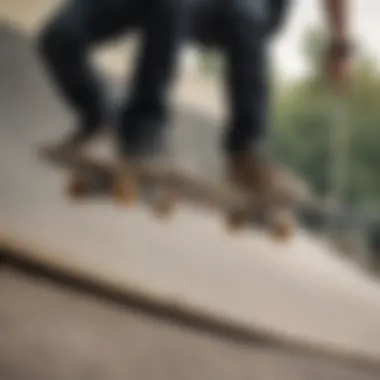
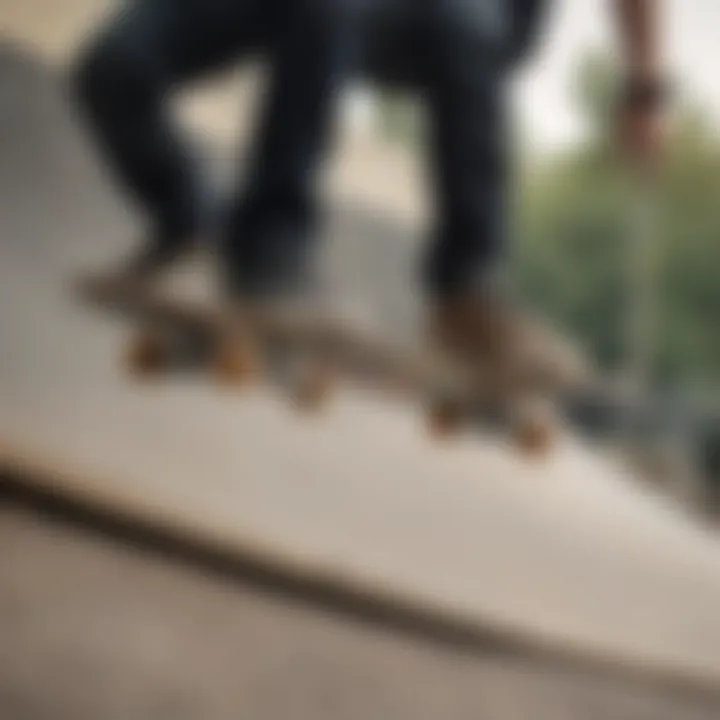
By highlighting both the pioneers and contemporary photographers, we start to see a clear lineage of influence and evolution in skate photography. This transformative journey not only serves the specific interest of skate enthusiasts but also invites a broader audience to appreciate the artistry that skateboarding encapsulates.
When examining influential skate photographers, it becomes evident that their works are critical in how skate culture is communicated to the outside world. They act as the bridge between the skate community and mainstream narratives. Without their vision and commitment to documenting this unique art form, much of the essence of skateboarding might remain hidden below the surface.
Cultural Impact of Skateboarding Images
The cultural impact of skateboarding images extends far beyond mere aesthetics; it represents a rich tapestry woven from the threads of rebellion, identity, and community. These images embody the spirit of skate culture, expressing a unique worldview that resonates with both skaters and non-skaters alike. Through visual artistry, skateboarding transcends the barriers of age, background, and even geography. Each photo, video, or meme encapsulates emotions, life stories, and aspirations, providing profound insights into the lives of those who skate.
Influencing Trends and Styles
The influence of skateboarding images on trends and styles cannot be underestimated. As much as skateboarding itself trends—with its ever-evolving tricks and techniques—the visuals associated with it are constantly reshaping the narrative. Consider this: a raw capture of a skater performing a trick can spark an entire fashion movement, where baggy pants, graphic tees, and worn-out shoes become synonymous with a lifestyle rather than just a sport.
Photographers like Atiba Jefferson and Spike Jonze have played a pivotal role in crafting these styles. Their imagery reflects more than the sport; it highlights a mentality. The angles they choose, the lighting, the skateparks or urban settings—these choices speak volumes. They draw people in, giving skaters a sense of belonging and identity while catching the eyes of the curious onlookers who may not even own a board.
With social media platforms like Instagram and TikTok, this influence has magnified. Images that trend often become the blueprints for upcoming styles, influencing how skaters dress and interact with each other both online and offline. It’s a cycle—board graphics inspire photographers, and then those photographs, in turn, inspire new generations of skaters and fans.
Bridging Skate Culture and Mainstream Media
Skateboarding images have also forged a critical bridge between skate culture and mainstream media. Once relegated to the outskirts of popular acceptance, this art form now holds a place on national and international stages. Brands, artists, and even filmmakers regularly tap into the visual language of skateboarding, illustrating its versatility and appeal.
While skate culture heavily emphasizes authenticity, mainstream depiction risks veering into the territory of commercialization. Yet, despite this tension, the marriage of skateboarding imagery and mainstream media often leads to beautiful collaborations that serve to expand and enrich the culture, as seen in campaigns from major clothing brands and films that resonate deeply with youth culture.
"The skateboarding image is not just a snapshot; it’s a powerful tool that reflects the essence of a culture."
Social media has been a double-edged sword, allowing widespread dissemination of skating images to enthusiastic audiences while also opening the floodgates for potential misunderstandings and misrepresentations. Overall, the interplay between skateboarding imagery and mainstream media underscores the continual evolution of both, inviting dialogue and debate on culture and identity while celebrating the raw creativity inherent in both realms.
In essence, the cultural impact of skateboarding images is profound. They serve not only as representations of a sport but as potent symbols of freedom, artistry, and community underpinned by shared experiences and shared dreams.
Technology's Role in Skateboarding Imagery
Technology has fundamentally reshaped how the skateboarding community captures and shares their experiences. From the advent of advanced digital photography to modern editing techniques, these innovations have elevated not just the aesthetics of skateboarding images but also their accessibility and reach. The interaction between technology and skateboarding imagery is profound, impacting everything from the portrayal of tricks to the audience’s immersive experience.
The Impact of Digital Photography
The transition to digital photography has been a game-changer for skateboarding visual culture. Gone are the days when photographers relied on film cameras, meticulously counting exposures and worrying about developing costs. Today, digital cameras allow immediate feedback after clicking the shutter, enabling photographers to explore creativity without the immediate concern for waste.
Convenience and Flexibility: With a digital camera, a photographer can shoot hundreds of frames in a short session, ensuring they capture that perfect moment. The ability to instantly review and adjust settings on the fly means that photographers can adapt to increasingly unpredictable conditions found in skateboarding, such as changing light or unanticipated movements.
High-Quality Outputs: Digital photography offers superior resolution and quality. Cameras are now capable of capturing stunning details, even in motion. For instance, the crispness of a well-timed shot of a skater landing a trick can convey the intensity of the moment much more effectively than before.
Ultimately, these capabilities transform how we see skateboarding, making it more dynamic and accessible to a wider audience.
Advancements in Editing and Production
In addition to capturing images, advancements in editing software have further transformed skateboarding imagery. Programs like Adobe Lightroom and Photoshop offer skater-photographers the tools to refine their work more than ever before.
Enhancing Visual Narrative: Photographers can now adjust colors, contrast, and even add effects to convey emotions or enhance the dramatic quality of the image. This has led to some breathtaking visuals that can truly capture the essence of a skateboarding session, showcasing the adrenaline and beauty of the sport.
Accessibility of Editing: As technology evolves, editing software has become more user-friendly. It allows novices to experiment and develop skills without extensive training. Many skaters themselves have taken to editing their images, creating a unique direct perspective that reflects their personal style.
Production Quality of Content:
The ability to edit images has led to a surge in high-quality skateboard content available on platforms like Instagram and TikTok, shaping how community members and outsiders view the culture. Today, it’s not just the tricks that grab attention; it’s also the quality of the imagery that can elevate a skater’s profile.
"The leap from traditional to digital photography is akin to skateboarding itself—it's about pushing boundaries and finding new ways to express yourself."
In summary, technology is at the heart of the transformation in skate imagery. Digital photography has made capturing skateboarding moments easier, while advancements in editing have allowed for deeper storytelling through visuals, creating a vibrant narrative that resonates with skaters and enthusiasts alike.
Social Media and Representation
Social media has become a monumental player in how skateboarding images are created, shared, and perceived. In this digital age, platforms like Instagram, Facebook, and Reddit have transformed the ways in which skaters connect, showcase their skills, and engage with their audiences. This shift is not just a passing trend; it's a fundamental change in the skateboarding community that deserves a deeper look.
Platforms Shaping Skateboarding Imagery
Social media platforms function as vast galleries of creativity. For instance, Instagram, with its visual-centric approach, has turned into a global stage for skateboarding. Skaters, amateurs, and pros alike use it to display their latest tricks and lifestyles, offering a real-time glimpse into their world. The hashtag culture allows for easy tracking of trends and movements within the skate community. You can search through #skateboarding or #skaterlife, stumbling upon countless images that tell unique stories.
- Instagram: This platform serves as a gallery for slick edits and lifestyle shots. The aesthetic appeal is paramount, often showcasing breathtaking photography.
- Facebook: It enables community building through groups where enthusiasts discuss techniques or share experiences and photos from local parks.
- Reddit: Here, subreddits like r/skateboarding allow for deeper discussions and critiques, providing a space for engagement beyond mere visuals.
These platforms, each contributing their own flair, shape the narrative of skateboarding imagery, creating a multifaceted portrayal that is both personal and communal.
The Democratization of Skateboarding Photography
The digital era has ushered in a democratization of skate photography. In the past, access to high-quality skate images often required professional gear or connections to established photographers. Now, with smart phones and affordable editing apps, almost anyone can capture and share their skate moments. This shift opens doors for diverse voices and stories that may otherwise go untold.
This newfound accessibility results in a more inclusive skate culture. No longer do visual narratives belong solely to elite skaters or renowned photographers; anyone with passion can contribute. Noteworthy aspects include:
- Increased Diversity: Diverse voices amplify different skate experiences, showcasing various cultures and communities.
- Realism Over Perfection: The rise of user-generated content often highlights authenticity over polished shots, capturing raw, genuine moments that resonate with many.
- Grassroots Movements: Smaller skate scenes can gain visibility and support through shared images, fostering local pride and participation.
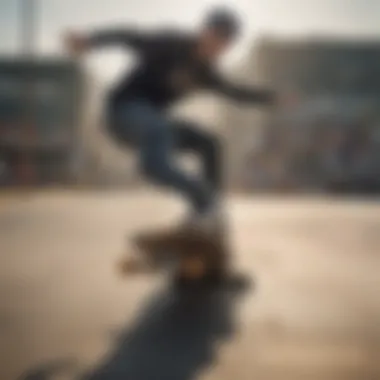
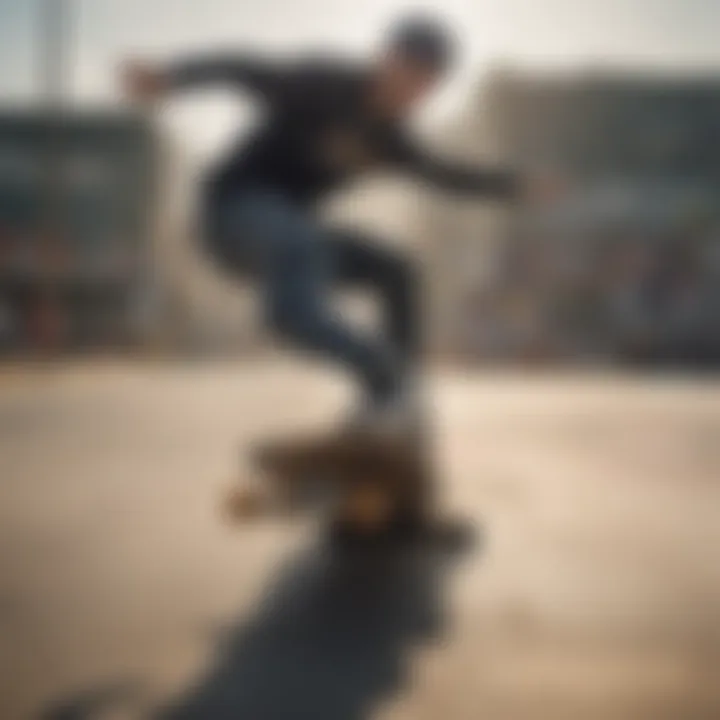
"In a world where anyone can be a photographer, the stories told through skateboarding images are as diverse as the skaters themselves."
As the boundaries continue to blur between amateur and professional, social media not only enhances representation but also fosters a broader understanding and appreciation of skateboarding culture—all contributing to a rich visual landscape.
The Narrative Power of Skateboarding Images
Skateboarding images hold a unique position in the wider realm of visual art and culture. They serve not just as snapshots of action, but as vessels of narrative significance. Exploring the narrative power of these images reveals the multifaceted ways they resonate, inspire, and engage audiences. They harvest stories, transmit emotions, and often forge new identities within the skate community. This interplay of personal and collective storytelling makes skateboarding imagery not merely an art form, but a transformative experience.
Telling Personal Stories Through Imagery
When you look at a skateboard photo, it often goes beyond the tricks being executed or the scenic spots chosen. Personal stories emerge from the frames. Each image can encapsulate an experience, a journey, or a particular phase in a skater's life. For instance, consider a photograph of a region's iconic skate spot, embodying the collective memories of skaters who have gathered there over the years. For them, that location could be rich with nostalgia, representing friendship, ambition, and growth.
Moreover, the skater's expression or stance depicted can inject a sense of individuality into the narrative, showcasing their relationship with the sport.
- Individual Challenges: Skateboarding can be a grueling journey of failures and triumphs. Every slide, flip, and fall photographed reflects resilience and determination.
- Community Influence: The influence of peers is significant in skating, and images often show the shared experiences of a crew, whether it’s cheering for each other from the sidelines or simply hanging out after a session.
- Evolving Style: Photographs can mark the evolution of a skater’s technique and style. They become a timeline of personal growth, revealing how practice leads to mastery.
In fact, many influential skate photographers have been adept at capturing these dimensions. They break the ice of mere technique to focus on the human aspect behind each trick.
Creating Community Bonds via Visual Narratives
Beyond individual stories, skateboarding images play a pivotal role in weaving the fabric of community. They transport a viewer into a space where camaraderie flourishes, creating visual narratives that resonate with broader emotions and shared experiences.
Skateboarding often thrives in local scenes where community is paramount. Images can depict local gatherings, spontaneous jam sessions, or even quiet moments of reflection. Through them, a network of relationships is visible, highlighting how skateboarding connects people across ages and backgrounds.
- Shared Experiences: An image of a skater attempting a trick surrounded by onlookers captures a moment of anticipation and support that strengthens community bonds.
- Cultural Heritage: Many skate spots capture the essence of their communities, and the images can become emblematic of local pride.
- Visual Advocacy: Skaters often use their platform to advocate for their communities, bringing attention to neglected spots needing recognition or upgrades.
"Images are more than just visual; they tell stories that define who we are and where we belong."
In essence, skateboarding images act as connectors. They validate experiences and establish an atmosphere of belonging that can sometimes be elusive in urban life. The narrative power embedded in these visuals enriches not only the culture of skateboarding but also the lives of those involved.
Contemporary Issues in Skateboarding Imagery
Contemporary issues in skateboarding imagery reflect the ongoing tensions and challenges that the skateboarding community faces in a rapidly changing landscape. Not only do these issues highlight the struggle for authenticity against the pressures of commercialization, but they also raise questions about censorship and freedom of expression. This section serves to illuminate how these elements intertwine and their implications for skaters, hobbyists, and instructors alike.
Authenticity vs. Commercialization
The concept of authenticity in skateboarding imagery is critical. Skaters often see themselves as part of an underground culture, deeply rooted in personal expression and community. However, as skateboarding has gained popularity, the lines between art and commerce blur.
When brands sponsor skaters or produce flashy marketing campaigns filled with exhilarating tricks, the challenge arises: does such commercialization dilute the essence of skate culture? Many might argue that these corporate influences intrude into what was once a grassroots movement. On the flip side, financial backing from brands can enable skaters to explore new creative avenues, fostering artistic growth.
- The debate over authenticity often revolves around key points:
- Corporate Sponsorships: Some purists feel that relying on brands for support leads to a loss of genuine self-expression.
- Artistic Freedom: Commercial interests can restrict a skater's true artistic voice, potentially stifling innovation.
- Community Growth: Conversely, commercial involvement can bring more visibility and resources to underfunded scenes, making skateboarding more accessible to diverse audiences.
Ultimately, this tug-of-war defines the current state of skateboarding imagery and continues to shape the culture.
Censorship and Freedom of Expression
Censorship is another pressing matter that skaters face today, particularly as skateboarding continues its transformation into a more mainstream activity. Some local governments and authorities often impose restrictions that affect where skaters can practice their craft, leading to potential clashes over freedom of expression.
For example, skate spots may be deemed illegal, pushing skaters to seek out concealed or unofficial locations, which can elevate the thrilling aspects of finding different terrains but also exposes them to the risk of legal consequences. This raises several crucial points for discussion:
- Space and Place: Skaters thrive in environments where they feel the most free to express themselves. Restricted spaces limit creativity and can lead to frustration within the community.
- Artistic Expression: When skateboarding images are suppressed or censored, the true representations of skaters and their culture are hindered. Censorship can lead to homogenized imagery that lacks the grit and passion inherent in real skate culture.
- Advocacy for Rights: Many within the skate community actively advocate for freedom of expression. This movement rests on the premise that everyone, regardless of skill level or background, deserves a chance to skate openly and creatively.
"Skateboarding is more than just a sport; it’s a means of self-expression. When we lose that, we lose a part of ourselves."
In light of these issues, skaters, hobbyists, and instructors are encouraged to engage with these contemporary dilemmas, ensuring that skateboarding continues to thrive as a distinct cultural art form.
Future of Skateboarding Images
The world of skateboarding images is constantly shifting, fueled by advancements in technology and evolving cultural dynamics. This section delves into the future of skateboarding imagery, emphasizing the significant trends and innovations that will shape the visual discourse in this realm. The discussion focuses on how these changes not only affect the art of skate photography but also influence skate culture and the broader social landscape.
Emerging Trends in Visual Representation
In recent years, skateboarding imagery has witnessed several trends that highlight a more inclusive and diverse representation within the sport. Here are some notable trends shaping the visual landscape:
- Inclusivity in Photography: The skate community is becoming more vocal about representation. Emerging photographers from various backgrounds are capturing stories that reflect a broader spectrum of experiences. This shift amplifies voices traditionally underrepresented in the skateboarding world.
- Realism and Authenticity: Skaters are gravitating towards more authentic and raw representations. The polished, overly stylized images are slowly making way for visuals that depict the gritty reality of skateboarding—complete with all the tumbles and triumphs.
- Crossover with Other Art Forms: As skateboarding integrates with various art styles—like street art and graphic design—imagery is becoming a melting pot of creativity. Skateboard graphics, photography, and videography interlink, pushing the boundaries of visual storytelling.
"Skateboarding is as much about an attitude as it is about the tricks; the images we capture reflect that spirit."
Implementing these trends fosters a richer visual narrative that resonates more profoundly with the audience, while also capturing the essence of skate culture.
The Role of Virtual and Augmented Reality
The introduction of virtual and augmented reality (VR and AR) is set to transform skateboarding imagery in ways previously thought unimaginable. Here's what to consider about how these technologies will impact skate photography:
- Immersive Experiences: VR can offer skaters and fans an immersive experience, allowing them to step into the shoes of professional skaters or even influence their skills through interactive features. By pairing VR with skateboarding imagery, the audience can connect in static images that come to life, making them feel part of the action.
- Enhanced Interaction with Content: AR can bring skateboarding images to life, enabling viewers to interact with the visuals. Imagine pointing your device at a skate magazine or mural and instantly getting a 360-degree view of a trick performed by a legendary skater.
- New Venues for Storytelling: Both VR and AR enable storytelling innovations. Skaters can share their narratives and experiences more engagingly. Telling a personal story through these mediums can result in a deeper connection with the skater's journey, incorporating elements that traditional photography might miss.
The future seems bright as these technologies promise to bring new dimensions to skateboarding imagery, emphasizing experiences that go beyond just the visual. As we navigate this convergence of art and technology, the skate community will undoubtedly continue to evolve, reflecting its dynamic spirit and artistry.







